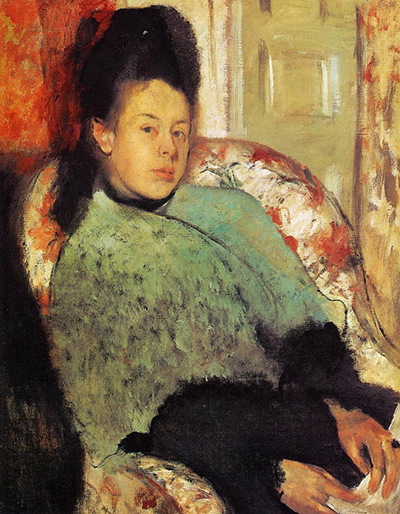The captivating artist Edgar Degas was immensely ahead of his time as a forefather of the impressionistic art movement.
The woman in the portrait is Elena Carafa, the artist's first cousin. Degas had visited her in Naples in 1875 for his uncle's funeral, and it is predicted that he created his masterpiece during the period. The oil on canvas piece is one of the few portraits the artist created. Degas was much more consumed with recreating authentic scenes, rather than painting forced imagery. Yet, once in a while Degas created a few portraits of those around him. One of his most prominent portraits is titled Madame De Rutte. It seems that Degas was captivated and believed that painting Elena would be his next move.
The muse is believed to have been 18 years old at the time of creation. She is seated on a large arm-chair that is covered in a floral pattern. Red flowers swirl into one another with a few dark stems along the way. Other shades of white and green fill the fabric of the chair. As Degas is immensely known for creating pieces based on a side profile, the portrait of Elena follows the rule. Degas tilts the chair to the side and has his cousin seated in a turned profile with her head facing a different direction. However, her eyes stare deeply into the viewer. The expression on her face seems to illustrate that even as the muse, she is also analyzing the viewer looking into her.
The woman's eyebrows are slightly raised while being quite thin. Her large eyes are delicately painted on the canvas in a realist detail. Her wide eyes look onto the viewer with shades of teal. Her face is shown perfectly in an oval with her plump orange coloured lips making a pout. The artist paints her nose in a tiny form, while making her ears appear largely. The woman's rich dark hair is placed in an up do upon her head, while part of it falls towards her back. The muse's face is immensly captivating as well as welcoming. Whereas in the artistÕs other portrait of Madame De Rutte, a dark threatening energy jumps through the canvas. The stunning element of Elena is the breath-taking shawl that she wears over her dress. Stunning shades of green and teal blend into one another as Degas uses small brush strokes to illustrate the lush fabric. It seems to resemble endless feathers, or a wool fabric. The breathtaking shawl truly captures as the focal point of the painting through the stunning technique Degas uses.
The artist gently merged all of the colours together by gently patting them into one another. The viewer can also spot dots filled with garden green and black throughout the piece. Yet they do not overpower the green shade that stands as the foundation. Elena is dressed in a black dress that goes towards her hands and waist. Degas decided to stick to a light colour panel and used rich pastel shades. This is evident through the yellow background wall with a white border. He uses a captivating blood orange shade to manifest a curtain near the left of the portrait. On the right, a stunning pattern fills another part of the canvas. All of these elements gently come together as one. Degas was brilliant enough to not use any cool shades, and instead stuck to warm colours that worked perfectly throughout the piece. This allows for Elena to seize the attention of the viewer, while giving off a positive energy that isn't too harsh.




